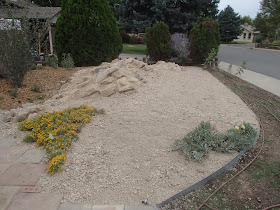Everyone is (supposed to be) thinking of their people this time of year, and expressing their gratitude and fondness for them. And gardeners, in the winter way, find ourselves pouring over seed catalogues and pictures. But my pictures, mostly plant pin-ups and wild landscapes, are strongly spiced with pictures of friends.

So, with less pesky writing, here are pictures of some of the best moments making friends in recent years and enjoying old ones in a life intertwined with plants.
All the volunteers who came to my rescue to plant a thousand rock garden plants at APEX
Including Ken Ray.
And Kevin Pykkonen, braving the Dasylirion texanum teeth, which was transplanted from the late Timberline Gardens in Arvada, CO
Marla Alexander, Herbalist extraordinaire and solid lifetime friend.
Deb Carr shines from the top of a crevice mound.

Gord from Colorado Springs is not afraid of cactus.
Van Milton, braving cactus planting as well.
Dom Turnbull, a home gardener who proves how much one can contribute to a greater cause, as a trough maker and crevice garden experimentalist.
And Dean, I think it is, in Montrose, helping build their Botanic's crevice garden with his practical tool tricks.
A handful of us in Montrose upon the building of the sandstone crevice garden.
In Vail, Nick Courtens and the new entry garden at the north end of Betty Ford Alpine Garden.
Jenny Wainwright-Klein from the Munich Botanic at Loveland Pass.
Yoko, propagator at Longwood (also at Loveland Pass, CO) and incredible outdoorswoman.
Glenn Guenterberg, new prez of RMC-NARGS (Denver's rock garden club) and supporter of Paintbrush and our exploits as well as rock gardening at large. Shopping for rocks!
Me and my friend Mike, also Paintbrush's versatile everything-expert, in the Northern LaSals, Utah.
We the "young turks" of North American rock gardening.
Joseph Tychonievich, Me, Nick Courtens, Adam Burch, and Mike Kintgen. I think we are all in our 30s now or close...
In Wyoming, The absolutely lovely Lisa Roper of Chanticleer Gardens, Philadelphia.
My longest-time Horticulture hero and I, the ubiquitous Panayoti Kelaidis.
From Western Colorado with Love.
Kenton
















































